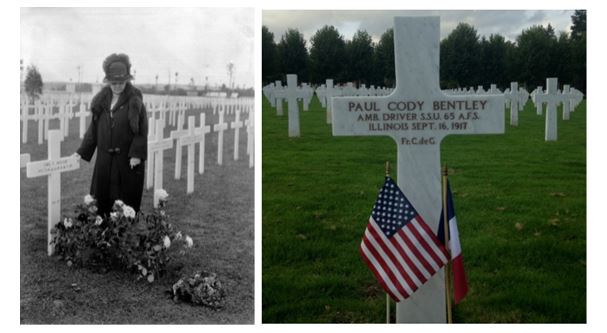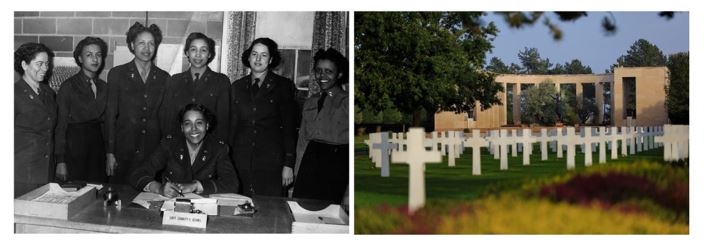The American Battle Monuments Commission (ABMC) commemorates this Women’s History Month by celebrating all women who have contributed to the war efforts and have served their country in countless ways.
Can you tell how many women served in uniform during World War II? Have you heard of the Gold Star Mothers and Widows Pilgrimages of the 1930s? Do you know when the first female ABMC superintendent was appointed? Here are eight interesting facts to honor and celebrate our service women this month:
The Gold Star Mothers and Widows Pilgrimages
In the aftermath of World War I, wives became widows and many mothers outlived their sons. More than 100,000 Americans died during the Great War, creating suffering and pain for those family members they left behind. Between 1930 and 1933, all mothers and un-remarried widows of those buried or memorialized overseas at an ABMC cemetery received an invitation to go on an official government-funded pilgrimage to visit their loved ones’ graves. Over the course of the program, 6,654 women participated. Through these pilgrimages, women played a key role in the early commemorations at the ABMC cemeteries. The government recognized that these women served the nation through their losses, and acknowledged the importance of providing them with the opportunity to visit the overseas graves of their fallen family members.
Learn more about the Gold Star Mothers and Widows Pilgrimages.

The Navy Yeoman in World War I
In one of the most iconic American recruiting posters of World War I, a young woman drawn by the famous artist Howard Chandler Christy posed in a man’s Navy uniform under the caption: “Gee!! I wish I were a man, I’d join the Navy.” This poster gave no indication that Bernice Tongate, the model, had actually enlisted in the U.S. Navy the very day that Christy sketched her. Along with over 12,000 other women, Tongate became part of the first group of American women to officially enlist in the U.S. military when she joined the Yeoman (F), the female section of the Navy created in 1917, just before the U.S. entered World War One.
Learn more about the Navy Yeoman in World War I.

ABMC’s first female commissioners
ABMC welcomed its first female commissioner, Josephine L. Bentley, at its creation in 1923. She was selected to represent Gold Star Mothers as her son, Paul C. Bentley, lost his life while serving as an ambulance driver with the American Field Service in World War I. He is buried at Oise-Aisne American Cemetery (Plot B, Row 12, Grave 2). The second woman to become an ABMC commissioner was Cora W. Baker, replacing Commissioner Bentley in 1929. She designed the battle map at the original Brest Monument as well as the artistic map of World War I sites that is displayed in the conference room at ABMC headquarters in Washington D.C. Today, ABMC’s Board of Commissioners includes Amy Looney Heffernan and Gail Berry West, both accomplished women in their own right and widows of American service members.

Josephine L. Bentley stands at her son’s grave at Oise-Aisne American Cemetery, 1920s.
A female artist behind the Honolulu Memorial’s battle maps
ABMC’s Honolulu Memorial honors the American armed forces who fought in the Pacific during World War II, the Korean War and the Vietnam War. The names of nearly 30,000 service members who lost their lives during these conflicts are memorialized on the Tablets of Missing. To honor their service and contextualize their losses, imposing mosaic battle maps were designed to adorn the Memorial loggias that flanked the Memorial Chapel. Mary Morse Hamilton Jacobs, a well-known artist from Baltimore, Maryland, has twice redesigned these mosaic battle maps displayed. Depicting the overall theater of operations and major battles sites, these mosaic maps are unique works of art, vibrant in color, and charged with honor and memory.
Learn more about the battle maps at the Honolulu Memorial.


Traumas of World War I: the Cromwell sisters
Buried side by side at Suresnes American Cemetery just outside Paris, lie the Cromwell sisters, who traded in a life of prominence in New York City to be frontline nurses during World War I. The twin sisters survived the war, but suffered from what is now known as post-traumatic stress disorder (PTSD). “World War I was a mercilessly heavy artillery conflict, to the extent that the phrase “shell shock” entered the public consciousness as an issue,” said Michael Knapp, chief of Historical Services for the American Battle Monuments Commission. “It is sort of the first time that people make that connection between the traumatic events of the war and the mental condition,” said Knapp. Gladys and Dorothy Cromwell posthumously received the Croix de Guerre, a French medal of valor, and the Medaille de La Reconnaissance, another French honor for civilians.

Learn more about the Cromwell sisters.
The 988 Suicide and Crisis Lifeline is a hotline for individuals in crisis or for those looking to help someone else. To speak with a trained listener, call 988. Visit 988lifeline.org for crisis chat services or for more information. The Veterans Crisis Line connects veterans and service members in crisis and their families and friends with qualified, caring U.S. Department of Veterans Affairs responders through a confidential hotline, online chat, or text. Dial 988 and Press 1 or visit veterancrisisline.net for crisis chat services and more information. The Crisis Text Line is a texting service for emotional crisis support. To text with a trained helper, text SAVE to 741741. It is free, available 24/7, and confidential.
The Six Triple Eight: a Women’s Army Corps unit predominantly composed of African American women
The 6888th Central Postal Directory Battalion, also called the Six Triple Eight, was a Women’s Army Corps unit that was predominantly composed of Black women that served in Europe during World War II (WWII). This battalion, composed of approximately 850 women, arrived in Europe in early 1945 to face the herculean task of sorting and delivering letters and packages that had been piling up in warehouses since D-Day, June 6, 1944.
While more than 6,500 African American women served the U.S., as many African American service members fought overseas during WWII, the role and presence overseas of the women of the 6888th was uncommon, and their mission unique: they were committed to succeeding and defeating the barrage of mail in the warehouses of Birmingham, England.
The 6888th Central Postal Directory served in the United Kingdom and France. Facing a backlog of mail, the “Six Triple Eight” worked in three shifts around the clock and processed some 65,000 pieces of mail per shift. Three members of the 6888th, Pfc. Mary J. Barlow, Pfc. Mary H. Bankston and Sgt. Dolores M. Browne, tragically lost their lives in a jeep accident on July 8, 1945. They are buried at Normandy American Cemetery.

Learn more about the 6888th Central Postal Directory Battalion.
Over 350,000 women served in uniform during WWII
During World War II, women supported and served our country abroad and at home. They served bravely and with distinction from the initial attack on Pearl Harbor, to V-E Day in Europe, through the last days of the Pacific campaign. Women in uniform not only assumed clerical positions to free more men for combat positions, they also drove trucks, repaired airplanes, worked as laboratory technicians, rigged parachutes, served as radio operators, analyzed photographs, flew military aircraft across the country, and test-flew newly repaired planes. Women in the Army Nurse Corps for example served near the front lines – 16 of them were killed as a result of direct enemy fire, including Aleda E. Lutz, one of the first American women to die in combat during World War II.
More than 350,000 women served in uniform during the war, with over 2,000 receiving decorations for valor.
Learn more about how women served during World War II.

Female superintendents at ABMC
ABMC’s first woman superintendent was selected in 2013. After serving 24 years in the U.S. Navy and 5 years as a NATO civilian, Tina Young joined ABMC in 2010 as Assistant Superintendent. Three years later, she was later selected to be Superintendent of the Sicily Rome American Cemetery, Italy. In 2015, she became the first Director of Cemetery Operations based in Paris, France. Her best and most profound memories are of escorting next of kin or family members to the headstones of their loved ones.
Today, from administrative assistants to assistant superintendents, from Commissioners to gardeners to interpretive guides, 116 women are present at ABMC headquarters offices and in Arlington and Paris and at many ABMC cemeteries, all working towards the same goal: honoring the service, achievements and sacrifice of U.S. armed forces.

This month, ABMC invites you to honor and remember those women who made the ultimate sacrifice, those who served in the past and those who continue to serve our country today.
 An official website of the United States government. Here's how you know.
An official website of the United States government. Here's how you know. 